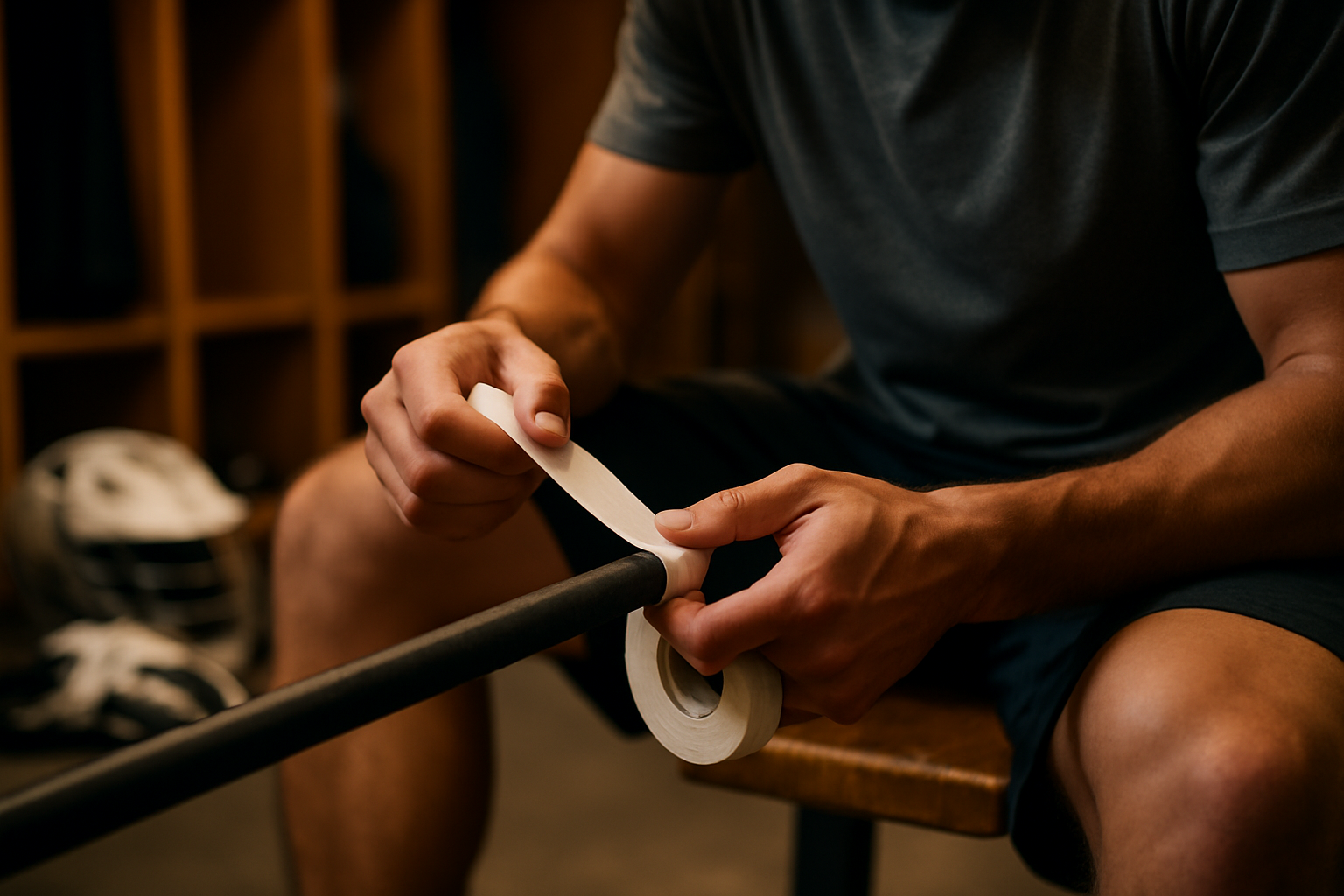

How to Tape a Lacrosse Stick: Rules, Styles & Techniques
Taping a lacrosse stick takes about 5 to 10 minutes and you only need athletic tape and a butt-end cap. Pretty straightforward.
Here's the thing: after outfitting hundreds of teams since 2009, we've seen just about every tape job imaginable. Some work, some fall apart after one practice, and some are just for show. What you'll find below are the five techniques that actually hold up during games, plus the official rules you need to know and some pro tips we've picked up from 15 years of equipping athletes.
You can go full mummy wrap for maximum grip, throw on a candy cane spiral for style points, or keep it minimal with strategic grip rings. The right choice depends on your position and what feels good in your hands. Let's get into it.
What Is Lacrosse Tape Used For?
Anyone who's played lacrosse knows that tape isn't just decoration. Here's what it actually does:
-
Secures the butt-end. That rubber cap on the bottom of your shaft? Tape keeps it from flying off when you're ripping shots or making hard passes. Trust me, you don't want that thing coming loose mid-game.
-
Gives you grip. Sweaty hands or wet weather can turn your shaft into a slippery mess. Tape adds traction right where you need it most.
-
Creates hand markers. Good tape jobs give you tactile cues so your hands land in the same spot every time. Consistency matters.
-
Required for faceoff guys. If you're taking draws, tape isn't optional. It's in the rulebook, and we'll cover that below.
-
Personalizes your stick. From candy canes to full coverage, your tape job is part of your identity on the field. Some players keep it clean, others go wild with it.
The thing is, you don't need to tape your entire shaft. Some positions barely use any tape at all. It's about finding what works for how you play.
Lacrosse Stick Tape Rules: What's Legal and What's Not
Let's start with the rule that gets players called out most often: tape cannot touch the head of your stick. Not even a little bit. Refs will catch it, and you're looking at a penalty. The only exception? Goalies can tape their heads all they want.
For All Field Players
Your butt-end has to be covered. That's a safety thing, and officials check for it. Beyond that, you can tape as much or as little of your shaft as you want. Any color works too.
Faceoff Player Requirements
If you're a FOGO or taking faceoffs, here's where it gets specific. You need tape on your stick, and it has to be a contrasting color from your head, shaft, and gloves. So if you're running a white shaft with white gloves, your tape needs to be literally any color except white. The tape starts near the throat without touching it and goes down exactly six inches.
Officials will check this before every faceoff. We've seen guys get benched because they showed up with white tape on a white setup.
The Bottom Line
Pro tip from our team sales experience: always check your league's specific rules before tournaments. Some youth leagues have their own quirks, and it's better to know beforehand than find out when you're trying to get on the field.
How to Tape a Lacrosse Stick: 5 Techniques (Step-by-Step)
Alright, here's where we get into the actual taping. Each style has its own vibe and works better for different positions. You've probably seen all of these on the field, and honestly, there's no wrong answer as long as it feels right in your hands.
Style 1: The Classic Wrap
This is the most popular tape style for a reason. Full or partial shaft coverage gives you maximum grip and it lasts forever.

Time: 5 to 10 minutes
-
Start at the butt-end and overlap onto the shaft by half an inch
-
Wrap upward toward the head at a slight angle
-
Overlap each layer by about 1/4 to 1/2 inch so there's no gaps
-
Keep going for however long you want (quarter shaft, half, or go full mummy)
-
Finish with one horizontal ring around the shaft and tear the tape
Best for: Beginners, box players, or anyone who wants serious grip without having to re-tape every week.
Pro tip from LBS: Most teams we outfit go with the half-shaft classic. It balances grip and hand mobility perfectly, especially for middies and attack who move their hands around a lot.
Style 2: The Candy Cane
The candy cane gives you grip without all the coverage. It's an angled spiral that looks clean and works great if your shaft already has some texture to it.

Time: 10 to 15 minutes
-
Tear your tape lengthwise into strips about 1/3 the original width
-
Secure the butt-end with a standard overlapping wrap
-
Angle the tape at 45 degrees and spiral up the shaft with even spacing
-
Stop anywhere from 6 to 12 inches up (that's the typical range)
-
Finish with a horizontal ring to lock it in place
Best for: Attack and midfield players with textured or sandblasted shafts who want some style mixed in.
Pro tip from LBS: Two-tone candy canes look sick. Our best-selling combo uses black and neon yellow athletic lacrosse grip tape. You can also match your team colors if you're coordinating with your squad.
Style 3: The Criss-Cross
You want style points? This is it. The criss-cross creates a diamond pattern that looks way harder to do than it actually is

Time: 15 to 20 minutes
-
Do the candy cane pattern first (see above)
-
Lock down the top with a horizontal ring
-
Now spiral back down at the opposite 45-degree angle
-
Cross over your original spirals to form those diamonds
-
Finish at the butt-end with another securing ring
Best for: Players who prioritize looking good over durability. You'll be re-taping this one weekly.
The catch: This style wears down the fastest by far. Teams we work with usually save criss-cross tape jobs for game day only and go with something simpler for practice.
Style 4: Grip Rings Only
If you hate the feel of tape or you're a pole who one-hands everything, grip rings might be your move. It's minimal coverage with tape only where your hands actually sit.

Time: 5 minutes
-
Tape up the butt-end like normal
-
Create rings that are 1 to 2 inches wide wherever your hands naturally grip
-
Common spots are right above the butt-end, mid-shaft, and up near the throat
-
Leave about 2 to 4 inches of space between each ring
-
Optional: add thin electrical tape rings between the main ones as hand guides
Best for: Defensemen, poles, and anyone who does a lot of one-hand cradling or checking.
Style 5: The Faceoff Specialist
This one's required if you're taking faceoffs. It's all about rules compliance, so let's keep it clean.

Time: 5 to 8 minutes
-
Pick a color that contrasts with your head, shaft, and gloves (check twice)
-
Start right at the throat without actually touching the head
-
Wrap tightly going downward for exactly 6 inches
-
Measure it to make sure you hit that 6-inch mark
-
Seal the edges with electrical tape so it doesn't fray during play
Best for: FOGOs and centers who take draws. Not optional for you guys.
Rules reminder: Double-check that contrast before games. White-on-white violations will get you pulled, and we've seen it happen more times than you'd think.
What Type of Athletic Tape Should You Use?
Not all tape is created equal. Here's what actually works for lacrosse sticks and what you should avoid.
Hockey Tape (Most Popular)
This is what most players use, and for good reason. It's 1 inch wide, cloth-backed, and designed for stick sports. You're looking at $2 to $5 per roll, which is pretty reasonable. Brands like Howies, Renfrew, and Elite Hockey Tape all make solid options.
The thing is, hockey tape just works. It sticks well, holds up to weather, and doesn't leave a weird residue when you finally peel it off. Check out our athletic tape collection if you're buying for a team. Bulk pricing makes way more sense than grabbing single rolls every week.
Lacrosse-Specific Tape
This stuff is slightly narrower than hockey tape, which makes it perfect for candy cane and criss-cross styles. You're paying a bit more at $3 to $6 per roll, but brands like StringKing, Jimalax, and East Coast Dyes know what lacrosse players need. Our single roll athletic lacrosse grip tape is a solid pick if you're just grabbing one for yourself.
Grip Tape (Premium Option)
Grip tape has a textured surface that gives you serious traction. It'll run you $5 to $8 per roll, so it's the priciest option. Best for wet weather games or box lacrosse where you're getting slammed around more.
Don't Use These
-
Baseball bat tape. Way too thick and the texture is all wrong for a lacrosse shaft.
-
Generic athletic wrap. It doesn't stick well enough and starts peeling after one practice.
-
Duct tape. Just don't. It leaves gross residue and isn't designed for sports equipment.
Buying Tips
Most tape jobs need 1 to 2 rolls depending on how much coverage you want. Teams ordering from our athletic tape collection usually grab 10-packs because the bulk savings add up fast. Plus, you get team-wide consistency when everyone's using the same tape.
Honestly, if you're not sure which type to go with, start with standard hockey tape. It's cheaper, easier to find, and works for any of the five styles we covered above.
Wrap It Up
So now you know how to tape a lacrosse stick five different ways, plus the rules and what materials actually work. The right style really comes down to your position and what feels good in your hands. Don't be afraid to experiment until you find your setup.
Here's the thing: since 2009, Lacrosse Ball Store has supplied athletic tape, gear, and custom team uniforms to hundreds of programs. Whether you need a single roll for yourself or bulk orders for your whole team, we've got you covered.
Questions about team orders or custom uniforms? Hit up our team sales at sales@lacrosseballstore.com or give us a call at (732) 431-2255. We'll help you figure out exactly what you need
